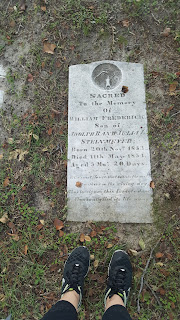I decided to do my Old Charlestonian research project on
Thomas Pinckney, but this Thomas Pinckney is famous for his work in the Civil
War, versus the most famous Thomas Pinckney who was famous in the Revolutionary
War. I wanted to do my research project on him because I have always loved to
research veterans, and I love researching the Civil War.
So, researching
Pinckney was a match made in heaven to me. I saw his gravesite at Magnolia
Cemetery when I went with the group for our blogpost. I fell in love with the
location of it and the simple design, but to me it was breathtaking and elegant.
His family plot houses his second wife and their daughter. As well as a
memorial for his first wife (unsure if she is buried there) and what I am
guessing is one of the six children he had with Mary (his first wife) and in
the back of the plot is another gravesite, but with my picture it is hard to
read and I found no further information.
As mentioned before, Pinckney was a part of the Civil War 4,
he was Captain in Hampton’s Legion Cavalry Battalion,th South
Carolina Cavalry regiment Rutledge Division, Co. D&E, St. James Mounted
Riflemen. His unit fought at Black River, Combahee River, The Wilderness,
Spotsylvania Courthouse, North Anna, Haw’s Shop, Cold Harbor, and the siege of
Petersburg.
His unit surrendered on April 25, 1865 at Durham Station,
North Carolina. He followed in his grandfather’s footsteps when joining the
military, but after the war he became a farmer.
 During his time in the war, he was a POW, a part of the
controversial “immortal 600” where they were forced to be human shields near
Charleston on Morris Island. The reasoning for this was for the Union general
to get his own revenge on a Confederate leader.
During his time in the war, he was a POW, a part of the
controversial “immortal 600” where they were forced to be human shields near
Charleston on Morris Island. The reasoning for this was for the Union general
to get his own revenge on a Confederate leader.
He was born on August 13, 1829 in Charleston County to
Charles Cotesworth Pinckney and Phoebe Elliott. His grandfather was the
governor of South Carolina and Ambassador to England. He did not know his
grandfather because he was born about a year after his death.
After having six children with Mary Stewart, she died, and
he remarried Camilla Scott and had one child, Josephine. He died in South
Carolina on November 15, 1915.
Thomas Pinckney comes from one of the most elite families
known. As stated, his grandfather is the most famous being the governor of
South Carolina and the mbassaador of England, but he also has more to his
family. With members in The Revolutionary War and War of 1812, there were many
war veterans within the family. This family also has its name signed into the
constitution.










































